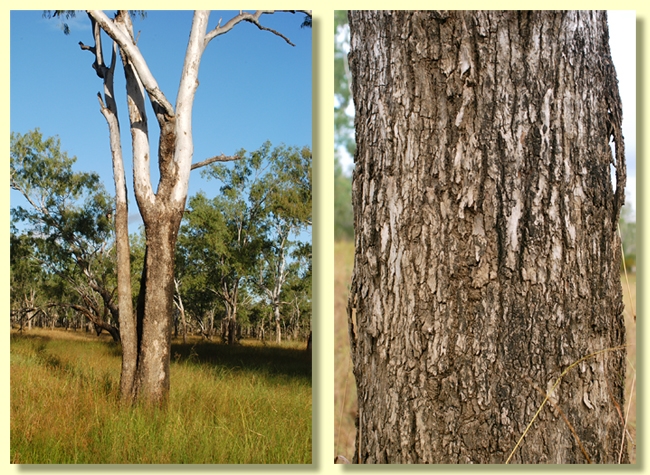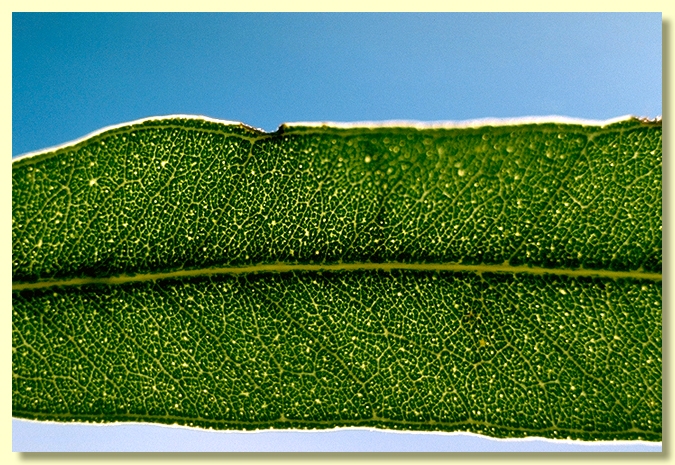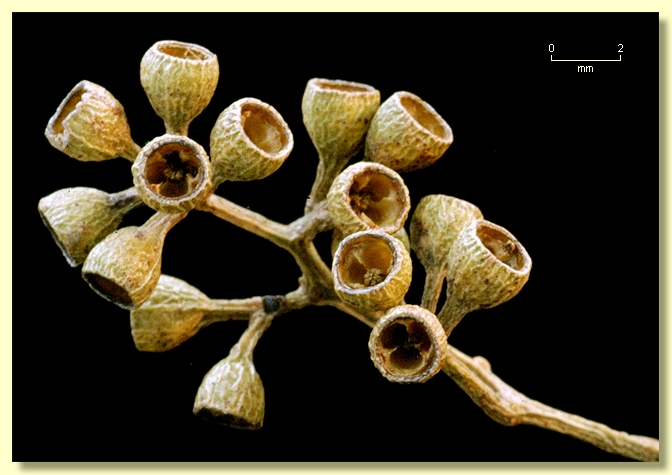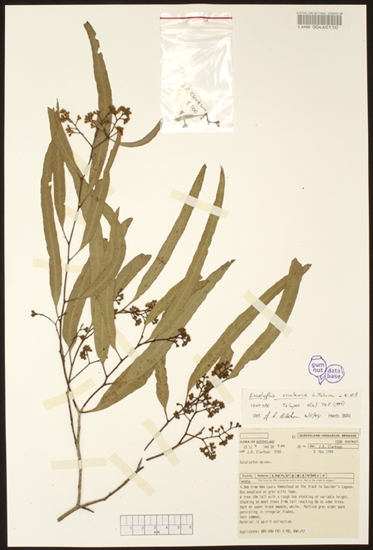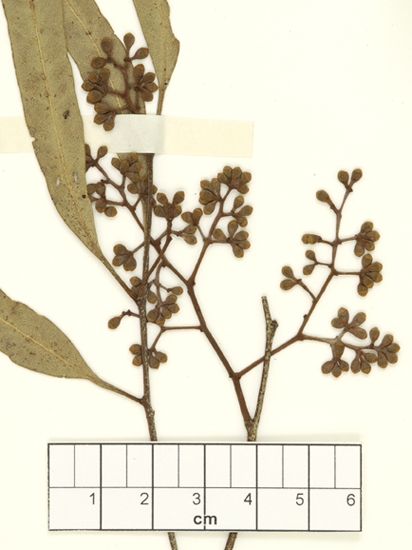Euclid - Online edition
Eucalyptus acroleuca
Eucalyptus | Symphyomyrtus | Adnataria | Apicales | Aquilonares | Protrusae
Tree to 15 m tall, sometimes taller to 25 m. Forming a lignotuber.
Bark rough on part or all of trunk, box-type or sometimes tessellated, grey or blackish, large branches and sometimes upper trunk smooth-barked, white to grey.
Branchlets lack oil glands in the pith; non-glaucous.
Juvenile growth (coppice or field seedlings to 50 cm): stems usually square in cross-section; juvenile leaves always petiolate, opposite for a few pairs then alternate, linear-lanceolate, 6–13 cm long, 0.7–1.1 cm wide, base tapering to petiole, dull, blue-green to blue-grey or ?slightly glaucous.
Adult leaves alternate, petiole 0.4–1(1.5) cm long; blade narrowly lanceolate, 7–14(17) cm long, 0.6–1.2(1.5) cm wide, base tapering to petiole, concolorous, dull to slightly glossy, green, side-veins acute or at an angle greater than 45° to midrib, densely reticulate, intramarginal vein parallel to and just within margin, oil glands intersectional.
Inflorescence mostly terminal compound, sometimes axillary panicles, peduncles 0.2–0.5(0.8) cm long, 7 buds per umbel, rarely 3, pedicels 0.1–0.3 cm long. Mature buds obovoid, 0.2–0.3 cm long, 0.1–0.2 cm wide, scar present (outer operculum lost early), operculum usually rounded, stamens irregularly flexed, anthers adnate, globular, dehiscing by lateral pores, style short, stigma blunt, locules 3 or 4, the placentae each with 4 vertical ovule rows. Flowers white.
Fruit on pedicels 0.1–0.3 cm long, cup-shaped, 0.2–0.3 cm long, 0.2–0.3 cm wide, thin-walled, disc descending, valves 3 or 4, enclosed or near the rim.
Seeds dark brown, 0.8–1.2 mm long, ovoid to flattened-ovoid, dorsal surface shallowly reticulate, hilum ventral.
Cultivated seedlings (measured at ca node 10): cotyledons small, reniform; stems square in cross-section, sometimes slightly warty; leaves always petiolate, opposite for 5 to 7 nodes then alternate, linear to narrowly lanceolate, 10–15.5 cm long, 0.5–1.1 cm wide, dull, green to grey-green, discolorous.
Flowering has been recorded in November and December.
A small to medium-sized tree endemic to Queensland and restricted to an area in the Lakefield National Park on Cape York Peninsula. Eucalyptus acroleuca forms pure stands in low-lying seasonally wet areas in heavy soils. It is characterised by its basal rough bark, conspicuously smooth-barked upper trunk and branches, narrow adult leaves and very small (0.2–0.3 cm wide), thin-walled cupular fruit with enclosed valves when dehisced and these features combined with its habitat will distinguish it from all others in its localized area.
In the classification of Brooker (2000) E. acroleuca belongs in Eucalyptus subgenus Symphyomyrtus section Adnataria (the boxes) because the buds have two opercula, ovules are in four rows, seeds are flattened-ovoid, cotyledons are reniform, and anthers are rigid on the staminal filaments. Within section Adnataria, E. acroleuca is part of a subgroup of box species with mostly tropical distribution, series Aquilonares subseries Protrusae, having inflorescences terminal on the branchlets, adult leaves very densely reticulate and fruit that are small, fragile and have exserted valves.
E. acroleuca is closely related to three other "coolibah" species: E. microtheca, E. coolabah, and E. victrix. Within this group, E. acroleuca is most likely to be confused with E. microtheca, but the latter has rough bark to the smallest branches and larger fruit 0.4–0.7 cm diameter; neither species has fruit with exserted valves. E. coolabah differs by having slightly wider adult leaves and hemispherical to funnel-shaped fruit 0.3–0.5 cm wide with strongly exserted valves, but has rough bark only on part of trunk with the upper bark smooth. The desert-dwelling E. victrix differs by being completely smooth-barked. All four species dwell in areas that are likely to temporarily flood after considerable rainfall.
Eucalyptus acroleuca: Greek acros, highest and leucos, white, referring to the white smooth-barked upper branches.


